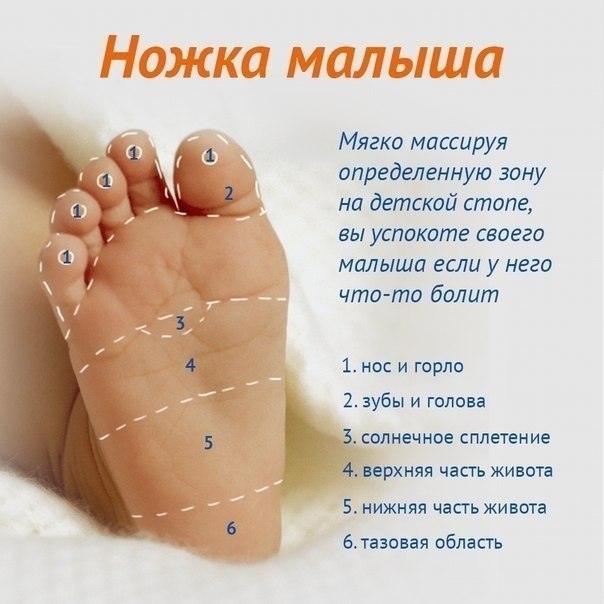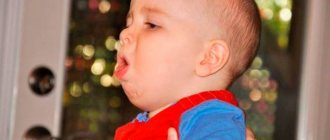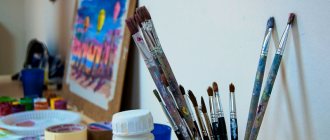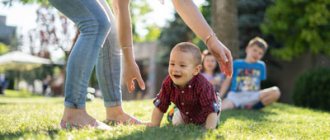Greetings, my dear friends and readers! Little children, up to one year old, need not only the right food, a lot of sleep, fresh air, walks and the boundless love of their parents. But also regular gymnastics! Yes, yes, high-quality gymnastics is almost a guarantee that the baby will develop properly.
And also - he will be a healthy, active, strong and strong baby. So how to do it right?
In this article I will tell you how gymnastics is useful for a 4 month old baby. And how it should be carried out, at home. So that its result is only benefit!
Why should it be done?
Four months is an important age for every baby. Now he is already actively interested in everything that surrounds him.
He sees well, hears well, feels a lot, and is even able to exhibit moderate motor activity!
His hands are already more skillful, they can hold objects. The legs are shaking, as if they want to start running faster! At this age, good gymnastics will help:
- develop and strengthen the baby’s muscles;
- strengthen the joints of the musculoskeletal system;
- improve coordination of movements;
- massage combined with gymnastics will strengthen the baby’s immunity;
- improve appetite;
- will contribute to harmonious development;
- improve thermoregulatory mechanisms;
- gymnastics combined with air baths (when the child is naked) is an excellent hardening procedure;
- All these activities not only develop, but also perfectly entertain, amuse children, and give them a great mood!
Why do you need a massage at 5 months?
As we know, a child grows and develops especially actively at first. So, for example, at the age of five months, the hypertonicity of the arm extensors disappears, and the baby begins to move relatively smoothly and coordinatedly. The baby's brain is mastering control of the body, but the child still lacks strength and physics. In addition to the above, a child with normal development at 5 months should already:
- be able to roll over from the back (possibly even over both barrels);
- start learning to crawl on your own;
- try to roll on the surface.
Massage at this age is especially important. Taking into account the gradual development of the infant’s motor activity, his muscles need to be actively supported. In addition, such actions are also very useful for strengthening the baby’s respiratory, circulatory, and cardiovascular systems. Moreover, the procedures have a beneficial effect on the baby’s nervous system and brain; he learns to regulate muscle excitation and inhibition. Massage at this age is also the prevention of many problems with the musculoskeletal system, such as torticollis.
However, massage is not only about physical development. At 5 months, babies begin to show interest in the world around them. They try to look at and touch surrounding objects and animals. At this time, it is especially important to talk to him, and the massage process is one of the best opportunities for communication between mother and baby. So, we have found out the developmental features of a child at 5 months and the importance of procedures of this kind for him. Next, we’ll talk about what types of massage infants should do at this age.
Important advice from experts
To ensure that your classes are 100% beneficial, follow these rules:
- do not start classes if your child is in a bad mood or sick;
- Do all exercises and movements as smoothly and carefully as possible, without unpleasant sensations for the baby or excessive effort;
- if the baby doesn’t like a particular movement, do it at the end so that you can quickly distract and calm it down with a rattle;
- the ideal time for gymnastics is morning;
- you should exercise an hour before a meal, or 1-2 hours after it;
- Ideally, you should repeat the exercises daily, or at least every other day;
- your hands should be warm, this is a very important rule;
- if the skin of your hands is excessively dry, lubricate it with baby cream or baby oil;
- if a child has any chronic illnesses, serious disorders, dysplasia, all exercises should be prescribed to him by his pediatrician;
- and it is better to keep the baby naked or in a diaper.
Exercises - step-by-step description
What “toddler” gymnastics is considered the main one? Below is exactly it, with the stages of doing it at home. The famous doctor Komarovsky also recommends just this kind of exercise:
- First, prepare your baby for exercise with a massage - gently rub his arms and legs in an upward direction. The baby lies on his back.
- Now stroke the chest, tummy, back, then the butt in a circular motion.
- Take him by the palms and carefully cross him on his chest several times.
- Take the baby by the feet and do the “bicycle” exercise - rotate your legs, imitating the pedaling of a bicycle, first forward, then backward.
- Do the “Boxer” exercise - make smooth movements with your arms, reminiscent of boxer lunges.
- Now “Mill” - fix the handles with your index and thumb, and slowly, carefully rotate in a circle, with a small amplitude, like a mill, saying “Where, where are our little hands? And here are our hands!”
- And now “Butterfly” for his tiny legs - bend them at the knees and carefully move them apart, pressing them to the surface.
- At the end, do the “Frog” exercise, which encourages the baby to move forward and, in the future, to crawl. Place him on his tummy in the “frog” position, his legs should be bent at the knee and hip joints and tucked in. Now place your hand under his feet, pushing him slightly. Place a bright toy in front of you as motivation.
Complete the gymnastics with gentle, relaxing strokes of the baby’s entire body.
If the descriptions given here do not give you a complete picture and 100% understanding, be sure to watch the video of what gymnastics massage is for a 4-month-old baby.
How to do a massage correctly
During the procedures, you can turn on calm meditative or classical music. The person performing the massage should be calm and relaxed: through touch, the child perceives mood and emotions.
Each technique is repeated no more than 8 times. The main thing for babies aged 4 months is to learn to understand hand movements and relax under their influence. The child is placed on his back. Begin the hand massage with stroking: it should be light and soft. Pressing or pinching is not acceptable. Hands are stroked in the direction from the hands to the shoulders in a circular motion. To strengthen the muscles of the shoulder girdle, at the end of the massage, the baby is allowed to grab his thumbs with his palms. Over time, the child will learn to pull himself up and hold himself in a sitting position.
How to massage the abdomen: place the baby on his back and stroke the tummy with your palms clockwise, without touching the liver area. After this, rub the oblique abdominal muscles with light pressure. Movements should be slow and not cause discomfort. At the end of the exercise, the fingers move upward, barely touching the baby’s skin.
To work on the spine and legs, the baby is placed on his back. Holding hands and holding the head, the baby is lifted. Hold for a few seconds and carefully return to the starting position. The result of the exercise is strengthening the muscles of the legs and back, neck, and abs.
To work the legs, place your palms on the inner and upper thighs. The movements are made in a clockwise direction, then a few light pinches are made with the thumb and index finger of the right hand. Left - supports the lower leg. The feet are rubbed and kneaded with the fingers, then along the outer side of the lower leg and thigh from the feet to the groin area.

The chest is massaged with light movements from the center to the hips and armpits. You can make fan-shaped or wave-like movements along the surface of the chest with your fingertips.
Read also…. Discomfort in the neck or back muscles after procedures
The back is massaged with the child lying on his stomach. Start with gentle stroking and kneading. Then they move on to pinching the longitudinal muscles: the gluteal muscles are worked first, and rise in the direction of movement to the seventh vertebra of the neck. They descend along the spine back to the gluteal muscles. The session ends with calm stroking.
And with a ball it’s more fun!
Exercising with a baby on a fitball is fun and useful. Many mothers are in vain afraid of this type of gymnastics, because of the instability of the ball. However, this type of exercise is simple and effective. Here's the easiest and safest thing you can do:
- place the baby on the ball, legs slightly apart;
- first, holding it firmly by the back, gently rock it to the sides;
- now turn the baby over on his back and rock him, holding him by the tummy;
- repeat steps 3-4 times.
Such exercises on the ball, like nothing else, contribute to the development of the vestibular apparatus of the infant. In addition, they develop flexibility and coordination of movements, strengthen muscles.
Complex 1. From 1.5 to 3 months. Balancing the tension
At this age, massage helps, first of all, to balance the tension in the extensor and flexor muscles of the legs and arms.
- Hand massage: smooth strokes (6 – 8 times).
- Raising from a supine position.
- Foot massage: stroking (6 – 8 times).
- Transferring to the stomach (15 – 20 seconds).
- Back massage: stroking (4 – 5 times).
- Spinal extension (2 – 3 times on each side).
- Abdominal massage: circular stroking (5 – 6 times); counter strokes (5 – 6 times); stroking the oblique abdominal muscles (5 – 6 times); circular stroking (5 – 6 times).
- Exercise to strengthen all abdominal muscles (2 – 3 times).
- Foot massage: stroking (5 – 6 times).
- Reflex extension and flexion of the feet (3 – 4 times).
- Reflex exercise “crawling” (2 – 3 times). Circular chest massage: vibration and stroking (5 – 6 times).
- Reflex exercise “walking” (2 – 3 times). Shaking hands.
- Rocking in the “fetal position” (2 – 3 times in each direction).
- Swinging on a ball.
Observe your child during massage and gymnastics. Surely you will notice that he already has favorite techniques and exercises that give him positive emotions. Next time you can start with them, this will immediately create a positive mood in the baby.
Gymnastics nursery rhyme
Gymnastics for children with nursery rhymes is useful, enjoyable and just fun! Say the nursery rhyme in a funny voice, and at the same time make movements for the baby, his arms and legs. The baby lies on his back. The nursery rhyme goes like this: our hands, don’t be bored (take the baby’s hands by the elbows), where you have been, answer (holding them by the elbows, bring your palms together in front of the child’s face, then spread them apart). Were you sitting at home (lightly clap your palms on his cheeks)? Then we went to our friends (slap your palms on your cheeks)!
In this verse, replace “hands, arms” with “legs, legs” and act carefully with your legs. Let your feet lightly touch, as if “hello” to each other.
Such activities will contribute not only to the physical but also to the speech development of your child.
Techniques for children's gymnastics
Gymnastics for newborns - a set of exercises
Gymnastics for infants 3-4 months is a complex of two types of actions:
- actions of a passive nature are performed by an adult;
- active actions - the adult encourages the child to actively participate.
During gymnastics, it is advisable to adhere to an algorithm that helps develop useful skills and habits:
- Preparatory massage movements - the baby’s arms and legs are carefully kneaded in an upward direction;
During the massage, an adult strokes the baby's tummy and chest, back and buttocks in a circular motion.
- Passive actions - the child is in a calm state, the adult stimulates the muscles of his arms and legs;
- The actions of the child himself are energetic movements with a rollover, encouragement to crawl and a fitball;
- The lesson ends with relaxation - calmly stroking the body to the music.
Life story
For example, my godson, the son of my friends, is growing up as a smart, very active, active and inquisitive child. And quite healthy, by the way, despite attending kindergarten. Now he is already 5 years old. But as a baby, he simply adored exercise.
Since his mother, an intelligent and responsible woman, taught him to do it. That is, she gave him massage and gymnastics, according to his age, almost every day. And I am sure that it is largely thanks to this that the child grows up so healthy, well-developed and capable.
Gymnastics for infants
Pediatricians recommend choosing a time to exercise with your child when he is in a good mood, feels normal and is ready to exercise.
By 3.5 months, the child should already be able to hold his head well
, lift your chest, and also lean on your hands independently. Exercises for infants at this age consist of placing the baby on his stomach as often as possible. This exercise will allow him to strengthen various muscles, especially the neck muscles.
At 4 months, when the baby learns to hold outstretched arms, leaning on the bed, you can do exercises that will help develop the ligamentous apparatus of the joints of the hands, as well as the muscles of the baby’s palms. To do this, the child must be taught to play “palm hands,” that is, clap his hands.
and hit the flat surface of a hard object with your palms.
Also, at 4 months, the child should be able to move his arms and legs freely more often, as this exercise helps strengthen the muscles of the upper and lower extremities.
Playing with various toys also helps strengthen the joints and muscles of the hands. It is best to buy rattles for your baby with a round, extended handle.
. While playing with toys, the baby should learn to put his thumb aside.
There is also gymnastics for infants, the exercises of which are closely related to massage.
Sliding steps
This exercise is used to strengthen and properly develop the joints and muscles of the legs.
. All movements must be done extremely carefully so that the baby does not get injured.
The child must be placed on his back, then you should take the baby's shin in your hands so that your thumb is on the inside of the shin.
Straighten the child's left leg and shake it slightly, then do a similar procedure with the right leg. During the exercise, the baby's heel should slide smoothly on the table
.
The exercise must be repeated 4 times with each leg.
Exercise "Walking"
Grab your child by the armpits, facing you, and lift him off the table. The baby's feet should lightly touch the table surface
. When the baby feels a hard surface, he will begin to reflexively move his legs.
Flexion and extension of the feet
Such gymnastics for infants helps strengthen the baby’s leg muscles. You need to take the baby by the heel and lightly press on the foot at the base of the toes
. The child's foot will reflexively flex. Next, rub the outer edge of your baby's foot to straighten it.
Exercise for baby's hands
Place your thumbs in the baby's palms and gently clench them into fists; the remaining fingers should clasp the baby's hands. First, gently shake your baby's hands
, bring them together on your chest and spread them in different directions. It is necessary to alternate the position of the hands so that either the right or the left hand is placed on top in turn. The exercise must be repeated 6 times.
Twist on stomach
Gymnastics for infants is very useful because it helps strengthen different muscle groups.
Place your baby on his back. Place the index finger of your left hand in the child's hand and hold his wrist with the rest. Holding your baby by the bottom of his shins, gently turn his pelvis to the right side. While turning, the baby's legs should be straightened. Reflexively, the baby will begin to turn his head
, shoulders and chest, and then independently roll over onto your tummy. The baby's arms should be placed under the chest, and the palms should lie straight.
Gymnastics for infants helps develop the baby’s muscular system, as well as strengthen his joints. Such exercises should be done at any opportunity.
Important addition
And another important point is fun music! Scientists have proven that musical exercises are several times more beneficial than “quiet” exercises for children.
After all, the sounds of music activate the senses, as well as brain activity. Therefore, you need to do exercises, including fun and dynamic children's songs.
And then the baby will be in a good mood, and he will “do” all the exercises with joy and pleasure! Personally, I believe in this conclusion of experts, and you?
So, now, dear readers, you also know how important gymnastics is for a 4-month-old baby. I hope the step-by-step charging instructions provided here will help you get it right. As a result, your baby will be healthy, satisfied and happy. I sincerely wish this for you! I also recommend looking at the articles on exercises for children at three months and educational games for babies at this age.
If you liked the article, share it on social networks. Also, leave your comments and subscribe to my blog. Here you will find many articles about health and development - children and adults. See you again!
Fourth month of life - exercise

Friday is here!











